Our communities are full of special places. Some of these places touch our national conscience while others have special meaning to only a few. Each of them contains stories of individual lives, some famous, most not, that when woven together over time create a tapestry that reveals who we are as a people. Unfortunately, many of these important places have disappeared from our landscape and our memories, leaving their stories, and the lessons learned, untold. But it doesn’t have to be this way. Together we can work to preserve our history for future generations so that they might benefit from learning the lessons of our own lives.
Restoration of the Williams-Earle Cabin
Greenville, SC
In January 2009, a group of teachers, students and preservation enthusiasts were offered the unique opportunity to rescue a historic cabin that was slated to be destroyed in order to make way for a new housing development. The cabin, constructed sometime in the 1840s, was originally built for slave families but served as a home for successive families of African-American freedmen farmers from emancipation through the Great Depression. What began as an attempt to save a building developed into an exciting initiative that has inspired a community to rediscover its past. With the gracious assistance of The History Channel and the National Trust for Historic Preservation, Greenville County Schools, in cooperation with the Greenville County Historic Preservation Commission is proud to be leading the innovative historic preservation initiative, If Walls Could Speak: African-American History of Greenville, 1790-1930. We hope you’ll join us in this exciting endeavor as we attempt to save the past for the benefit of future generations.
Walls can speak. Listen.
Phase 1
Phase one of the project delt with documenting as best as possible the families involved with the Williams-Earle property, both slave and free. This research spanned three centuries and is shedding light upon the lost and/or neglected history of the relationships formed between Whites and African-Americans in early Greenville County and the impact that these relationships had, and still have, on our community.
Phase 2
Phase Two of the project involved completing a ten-day archaeological survey of the Williams-Earle estate. Students, teachers and community volunteers assisted with this process. Hundreds of artifacts were recovered and catalogued.
Phase 3
Phase three of the project involved the careful disassembling of the cabin in order to move it to its new home on the Living History Farm at Roper Mountain Science Center. This process took three days to complete.
In March of 2009, the cabin was transported via two trailers to the Living History Farm, where it waited eight months to be rebuilt. Roper Mountain Science Center and its Living History Farm are owned and operated by Greenville County Schools and provide programming for students not only in Greenville, but also for districts across the state as well as the public at large.
Phase 4
Phase four involved the reconstruction, restoration, and interpretation of the cabin. This is authentic, hands-on learning at its best! More than twenty middle school and high school students worked together with numerous adult volunteers to painstakingly piece the cabin back together, all the while making numerous repairs to strengthen it.
Photo Gallery | |
|---|---|
 Sifting for artifacts |
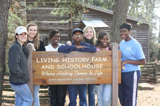 Students lending a hand with reassembly |
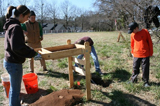 More sifting |
 Rebuilding the foundation |
 Rebuilding the foundation |
 Old newspapers (1907) used for wallpaper |
 Placing a floor joist |
 Students preparing new floor boards |
 "Pepe the Possum" |
 Hand-blown glass bottle neck; c. 1860s |
 English whiteware with cotton pattern; c. 1850s |
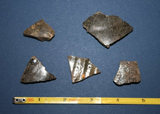 Green salt-glazed pottery sherds |
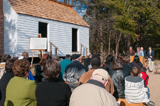 Dedicating the cabin at Roper Mountain |
 Thomas Riddle speaking at the Dedication Ceremony |
 Being honored with the Preserve America Community Award |
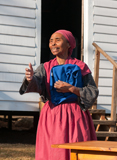 Actress and historic interpreter Miss Kitty Evans Wilson performs in her role as "Kessie," a slave who, in this performance, has been recently freed |
 Keya Talley & Sydney Johnson with their drawing of the cabin |
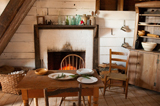 Inside the restored cabin |
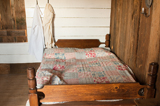 Inside the restored cabin |
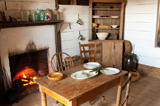 Inside the restored cabin |
What You Can Do
While older buildings embody our history, and that's one reason why it's important to save them, that isn't the only reason. Many older buildings are important – and worth preserving – simply because they're good to look at. They are "a gift to the street" whose style, textures, materials, and charm (and maybe even eccentricity) enrich and enliven their surroundings. These buildings are worth saving because our communities would be less interesting, less attractive, and less distinctive without them.
Other buildings are worth saving because they have plenty of good use left in them. Innovative examples of "adaptive use" can be found everywhere. Warehouses have been reborn as restaurants, mills converted into condominiums, houses transformed into museums, proud old hotels that have been restored to prominence, and on and on. The process of adaptive use not only protects historic structures but also is good for the environment – think of it as the ultimate form of recycling.
How You Can Learn About and Help Preserve Historic Places in Your Community
Everyone has a role to play in helping preserve our past; and you don’t have to be a professional historian or preservationist to make a difference. How can you start to help? Try one or more of the following activities:
Explore Family History:
investigate the
places that are significant to you and your
relatives, including schools, churches, home
places, etc.
Ask Neighbors about the
Neighborhood:
talk to people who’ve
lived on your street for a long time. Find
out what they remember about living there
and about the people who have moved on.
Visit Main Street:
traditional commercial
districts often have unique buildings and
feature locally-owned stores that
are vital parts of the community.
Identify buildings that you like and
research their history.
Take a Home Town Tour:
Visit
historic sites in your area or plan a
trip to your local history museums.
Read All About It:
Before or
after exploring your community, be
sure to find out more by reading all
about it. Many communities have a
book (or several) about its local
history. These will be available at
your library, historical society, or
favorite book store.









